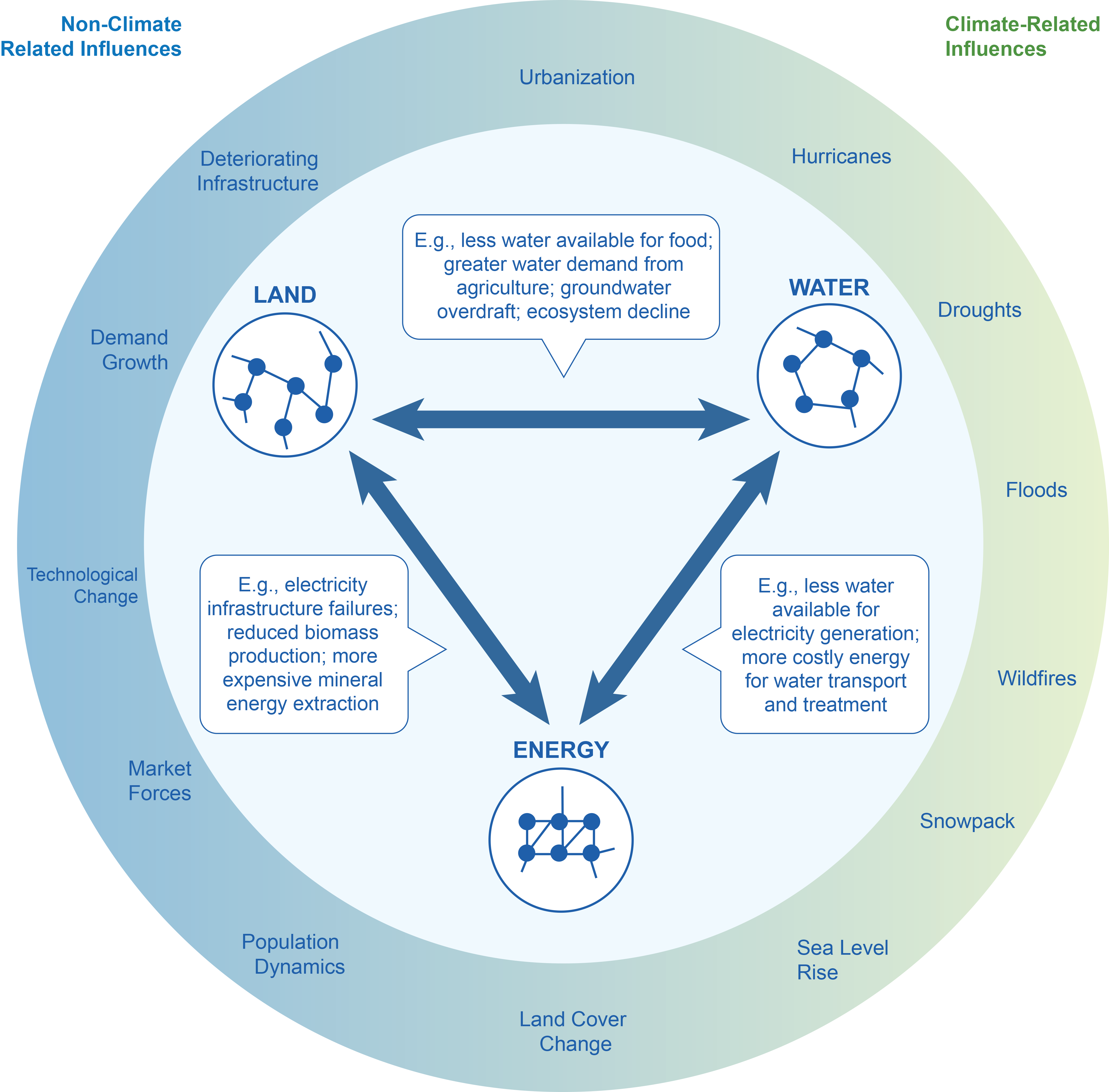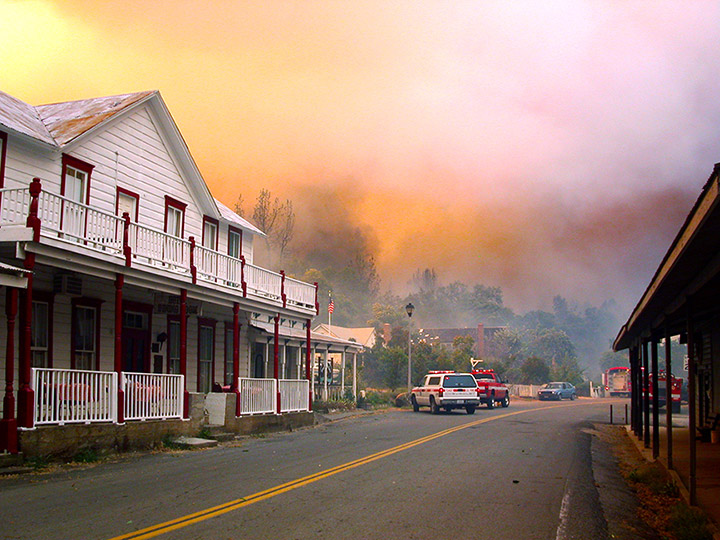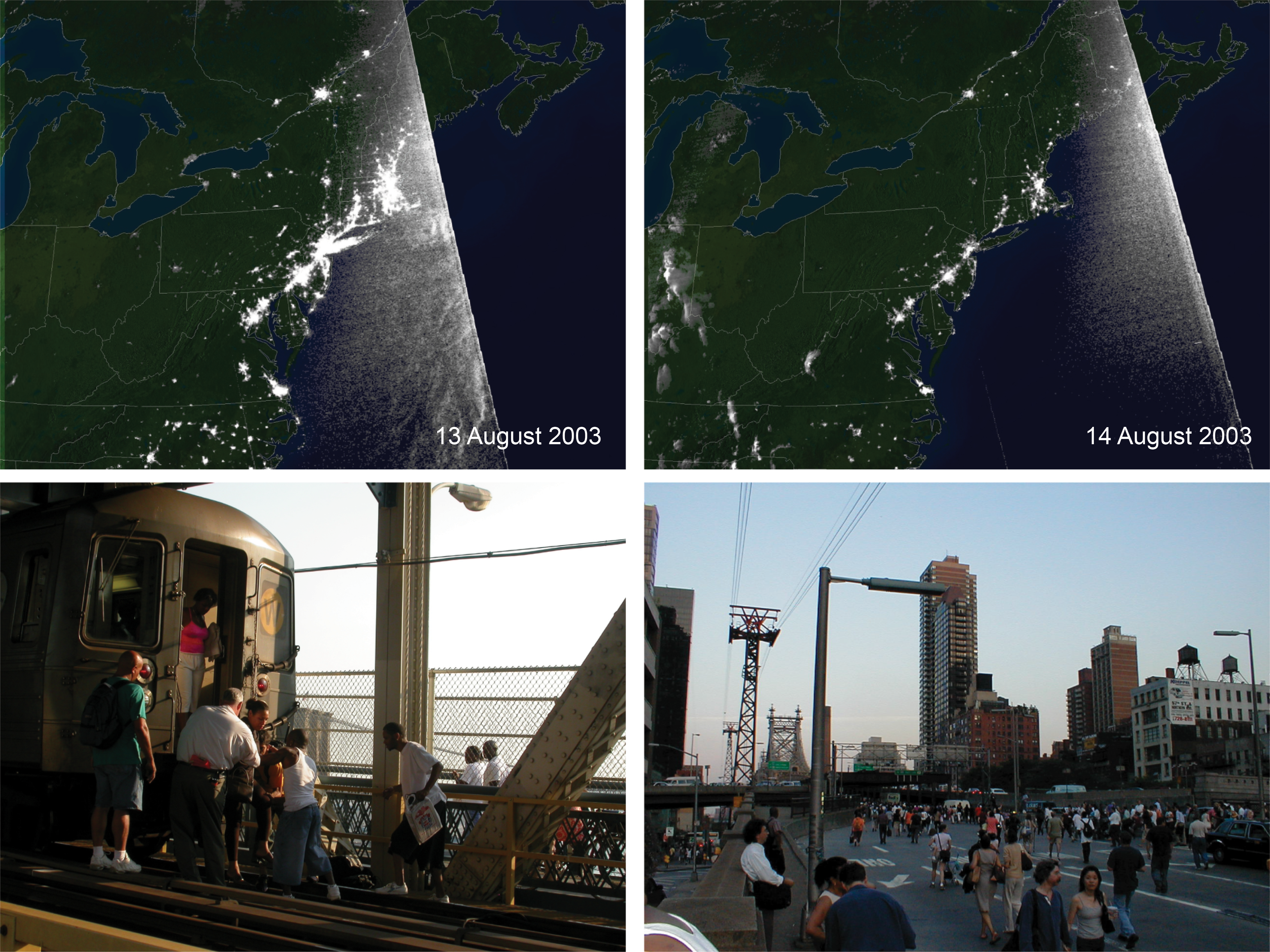The scope of this chapter was developed to fill a gap in previous National Climate Assessments (NCAs), notably the risks that emerge from interactions among sectors. Previous NCAs have touched on this subject, for example the energy, water, and land use chapter in the Third National Climate Assessment (NCA3). However, these assessments never included a chapter specifically focused on a general treatment of this topic. Emerging scientific research is highlighting the links between sectors and the potential complexity and implications of these interactions, from complex system dynamics such as cascading failures to management approaches and approaches to risk. These concepts were then incorporated into a detailed terms of reference for the chapter, outlining the scope and the general content to be included in the document.
The author team for this chapter was constructed to bring together the necessary diverse experience, expertise, and perspectives. Our authors brought expertise and experience in multiscale, multisector research and modeling, with a focus in specific sectors or sectoral combinations including critical infrastructure, energy–water–land interactions, and ecosystems. The authors also had expertise in complex systems science and previous experience in assessment processes.
The chapter was developed through technical discussions, a literature review, and expert deliberation by chapter authors through email and phone discussions. The team evaluated the state of the science on the analysis of sectoral interdependencies, compounding stressors, and complex system science. Case studies were drawn from a range of sources intended to represent the key themes in the chapter.
Key Message 1: Interactions Among Sectors
The sectors and systems exposed to climate (for example, energy, water, and agriculture) interact with and depend on one another and other systems less directly exposed to climate (such as the financial sector). In addition, these interacting systems are not only exposed to climate-related stressors such as floods, droughts, and heat waves, they are also subject to a range of non-climate factors, from population movements to economic fluctuations to urban expansion. These interactions can lead to complex behaviors and outcomes that are difficult to predict. It is not possible to fully understand the implications of climate change on the United States without considering the interactions among sectors and their consequences. (High Confidence)
Description of evidence base
A suite of examples across this assessment and within this chapter demonstrate the interactions between systems and the potentially important implications of these linkages. Examples in this chapter include Hurricane Harvey; the 2003 Northeast blackout; energy–water–land systems in California and throughout the nation; forest systems facing influences from wildfires, drought, and pine bark beetles; and the implications of the reintroduction of wolves in Yellowstone. Each of these examples is supported by its own evidence base; the linkages between systems and the importance of non-climate influences is self-evident from these examples. Beyond these examples, a small set of recent literature has begun to explore ways to more systematically quantify the implications of including sectoral interdependencies in climate risk assessment (e.g., Harrison et al. 20168).
In addition to literature specific to risk assessment in the context of climate change, there is a long history of research on complex systems11 that raises the potential for a range of dynamics that might emerge from sectoral interdependencies and compounding stressors. This includes research spanning disciplines from meteorology12 to ecology13 to paleontology14 to computer science.15 This literature supports the conclusion that more complex dynamics may occur when multiple systems interact with one another.
Major uncertainties
The interactions between sectors and systems relevant to climate risk assessment are self-evident, and there are clear examples of unanticipated dynamics emerging from these interactions in the past. Yet our understanding is limited regarding the precise nature of complex system behavior in the context of climate risk assessment and its ultimate influence on the outcomes of such assessments. As noted in Key Message 4, the available tools and frameworks are simply not sufficient at this point to identify key risks emerging from intersectoral interdependencies and compounding stressors.
Description of confidence and likelihood
We have high confidence in this message, because there is high agreement and extensive evidence that a range of critical intersectoral interdependencies and compounding stressors are present and relevant to climate risk assessment. At the same time, the precise impact of these on system dynamics is not well understood.
Key Message 2: Multisector Risk Assessment
Climate change risk assessment benefits from a multisector perspective, encompassing interactions among sectors and both climate and non-climate stressors. Because such interactions and their consequences can be challenging to identify in advance, effectively assessing multisector risks requires tools and approaches that integrate diverse evidence and that consider a wide range of possible outcomes. (High Confidence)
Description of evidence base
Recent climate change assessments (e.g., Oppenheimer et al. 2014, Houser et al. 201545,46) emphasize that a multisector perspective expands the scope of relevant risks and uncertainties associated with climate change impacts. Assessing these risks requires attention to multiple interacting sectors, geographic regions, and stressors, such as 1) interactions in the management of water, land, and energy (see Box 17.3), or 2) spatial compounding of impacts if, for example, multiple infrastructure systems fail within a city (see Box 17.1). Risk assessment also requires attention to indirect and long-distance climate change impacts, for instance resulting from human migration or conflict.45,100 Analyses of historical events (see Box 17.5), evaluations of statistical risk (e.g., Carleton and Hsiang 2016101), and process-based modeling projections are some of the methods demonstrating these complex interactions across sectors, scales, and stressors.
Different tools and approaches are required to assess multisector risks. Approaches can be applied to integrate diverse evidence, combining quantitative and qualitative results and drawing from the natural and social sciences and other forms of analysis.47,49,51 For instance, models and expert judgment have been used together to inform our understanding of future sea level rise,52 and scenarios can also be used to explore preparedness across possible futures.53,54,55
Major Uncertainties
For interdependent systems affected by multiple stressors, the number and complexity of possible interactions are greater, presenting deeper uncertainties. It is often difficult or impossible to represent all relevant processes and interactions in analyses of risks, especially quantitatively. For example, quantitative projections can evaluate probabilities of well-understood sectoral interactions but will be limited by processes or parameters that are poorly known or unknowable. This is why the integration of diverse evidence and attention to deeper uncertainties are important in multisector risk assessment.
Description of confidence and likelihood
We have high confidence in this Key Message because there is high agreement that a multisector perspective alters risk assessment, as is reflected in recent climate change assessments. However, the evidence basis for multisector evaluations is emerging.
Key Message 3: Management of Interacting Systems
The joint management of interacting systems can enhance the resilience of communities, industries, and ecosystems to climate-related stressors. For example, during drought events, river operations can be managed to balance water demand for drinking water, navigation, and electricity production. Such integrated approaches can help avoid missed opportunities or unanticipated tradeoffs associated with the implementation of management responses to climate-related stressors. (High Confidence)
Description of evidence base
Recent literature has documented that the management of interacting infrastructure systems is a key factor influencing their resilience to climate and other stressors. A range of studies have argued that the complexity of institutional arrangements in mature, democratic economies like the United States poses challenges to the pursuit of climate adaptation objectives and sustainability more broadly.72,102,103,104,105 The complexity associated with interacting systems of systems poses significant challenges to integrated management.105 The allocation of authority and responsibility for system management across multiple levels of government as well as between public and private sectors often contributes to decision-making by one actor being enabled or constrained by other actors.72,103
The interdependencies among systems reflect the potential value in the development of more integrated management strategies.72 This concept of integrated management is reflected in existing literatures, particularly those associated with integrated water resources management 106,107,108,109 and integrated infrastructure planning.110,111,112 Such studies often address integration within sectors or systems, with less consideration for integration between or among systems. This has the potential to lead to missed opportunities for improving management practice.72 However, assessments of energy,113 urban infrastructure,75 and coupled energy–water–land114 systems conducted as part of NCA344 identified a range of interdependencies across multiple sectors (see Dawson 2015115).
A range of strategies have been proposed for enhancing the capacity to manage system interdependencies and climate change risk. Significant effort has been invested in understanding and modeling system dynamics to enhance capabilities for risk and vulnerability assessment. These efforts have largely focused on physical infrastructure systems, infrastructure networks, and the potential for cascading failures.116,117,118,119 Such capabilities help to identify what can be monitored in complex systems to enhance situational awareness, anticipate disruptions, and increase resilience.71,120,121
There is ample evidence of comanagement of interdependent systems, often as a function of resource assurance and/or contingency planning. For example, the use of water for electricity generation (hydropower or cooling in thermal generation) involves regulatory constraints around water use as well as operational decision-making regarding water management.72,114,122,123,124,125 These interactions have been a major focus of studies addressing the climate–water–energy nexus. Meanwhile, emergency managers as well as agricultural, commercial, and industrial supply chains often develop contingency plans in the event of disruptions of transportation, telecommunications, water, and/or electricity.81,126,127,128,129
A key element of such planning is to build redundancy and flexibility into system operations.73 Evidence suggests that adding flexibility or robustness to systems or transforming systems such that they interact or behave in fundamentally different ways can increase construction, maintenance, or procurement costs.82,130,131 However, a number of studies exploring the valuation of resilience actions and investments have concluded that the benefits of resilience interventions can be significantly greater than the costs, provided the long-term mitigating effects of the intervention are factored in.132,133,134
Given the complexity of governance systems, the responsibility for the design and implementation of such strategies for integrated management rests on a broad range of actors. Over the latter part of the 20th century, the privatization of infrastructure, including energy, telecommunications, and water, transferred infrastructure management, responsibility, and risk to the private sector.135 Nevertheless, local, state, and federal governments continue to have critical roles in regulation, risk assessment, and research and development. In addition, many institutions, organizations, and individuals either have infrastructure dependencies or influence the dynamics, operations, investment, and performance of infrastructure.136 The increasing interconnectedness of both infrastructure and the people who use and manage that infrastructure is leading to both new challenges and opportunities for comanaging these systems, particularly in urban areas.137,138,139 A growing literature is identifying opportunities to enhance consideration of human health and other benefits in the design of urban landscapes and infrastructure.67,140,141,142,143
Major Uncertainties
The dominant uncertainties associated with the management of climate risks and system interdependencies include understanding indirect effects and feedbacks between systems, particularly with respect to predicting system responses. Technological change could have significant implications for the resilience, interconnectedness, and responses of systems to climate-related stressors and other disturbances. Such change could increase the complexity of integrated management with implications that could be positive or negative with respect to vulnerability. In addition, the future evolution of governance and regulatory dimensions of infrastructures systems, as well as consumer choices and behavior, are associated with irreducible uncertainty, largely because they involve choices yet to be made.
Description of confidence and likelihood
There is high agreement and extensive evidence that institutional arrangements and governance are critical to the management of systems and their interdependencies. This finding is reflected in scientific assessments, modeling studies, and observations of system responses and performance, as well as in theories emerging from complex systems science. Furthermore, a history of management practice associated with water, energy, transportation, telecommunications, food, and health systems that spans decades to centuries provides evidence for the importance of system interdependencies. Thus, there is high Confidence in this message.
Key Message 4: Advancing Knowledge
Predicting the responses of complex, interdependent systems will depend on developing meaningful models of multiple, diverse systems, including human systems, and methods for characterizing uncertainty. (High Confidence)
Description of evidence base
This Key Message is based on an understanding of a range of analyses and modeling tools described throughout the chapter.
Major Uncertainties
Because the Key Message is the authors’ assessment of the overall state of development of research tools and models, and the subsequent importance of developing research tools, the concept of major uncertainties is not entirely appropriate. This is a matter of the authors’ judgment, not calculation or assessment of underlying probabilities.
Description of confidence and likelihood
See above. No likelihood statement is appropriate, and the high confidence is based on the authors’ assessment of the underlying literature and development of methods and modeling tools.








